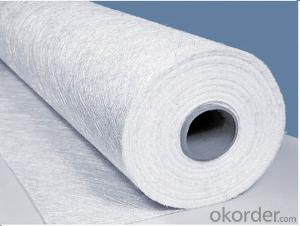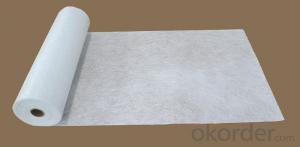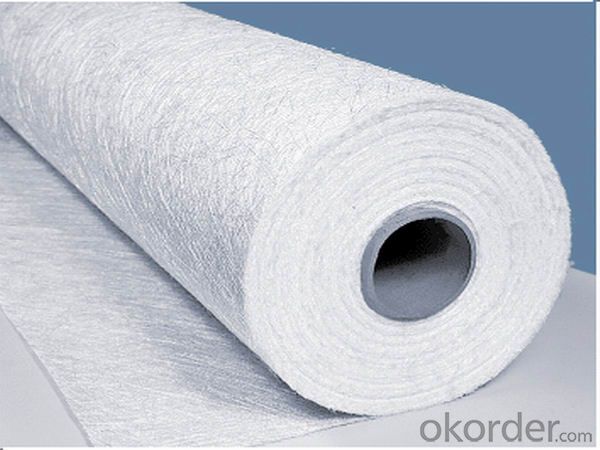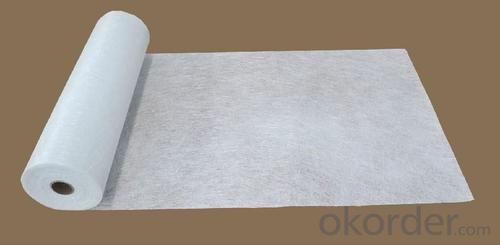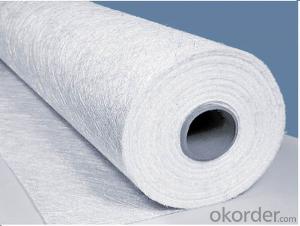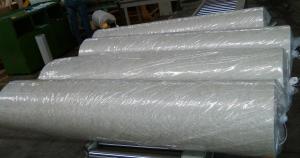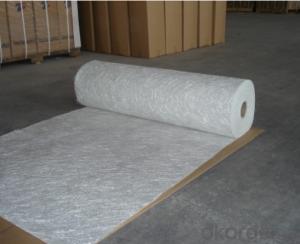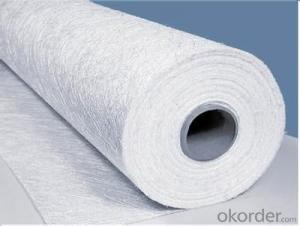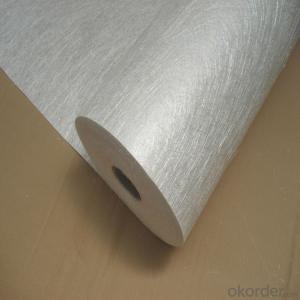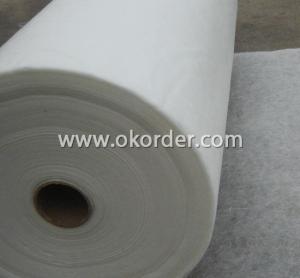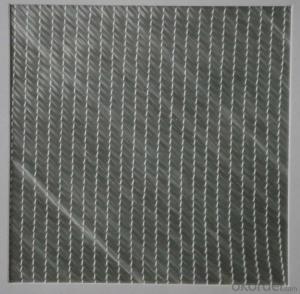E-glass Fiber Powder Bonded Chopped Strand Mat
- Loading Port:
- Shanghai
- Payment Terms:
- TT or LC
- Min Order Qty:
- 20000 kg
- Supply Capability:
- 200000 kg/month
OKorder Service Pledge
OKorder Financial Service
You Might Also Like
Brief Introduction
Fiberglass chopped strand mat is an non-woven E- or C-glass fiberglass fabric manufactured by spreading continuous filament rovings of 50mm in length randomly and uniformly in combination with polyester binder in power form (or other binder in emulsion form).
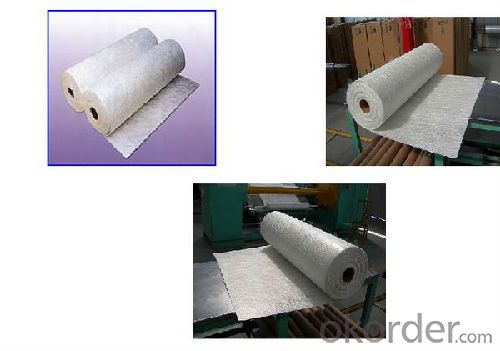
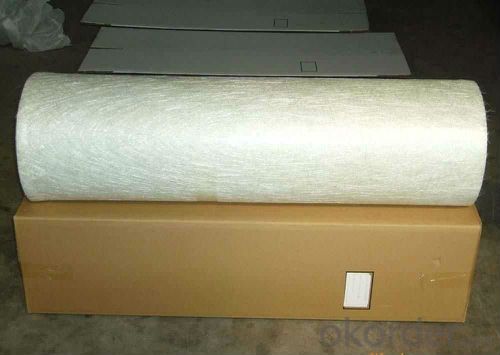
Product Features:
Fast breakdown in styrene
High tensile strength, allowing for use in hand lay-up process to produce large-area parts
Good wet-through and fast wet-out in resins, rapid air lease
Superior acid corrosion resistance
Product Specifications:
Property | Glass type | Weight(g/m2) | Width 200~3300 | Roll Weight | Moisture Content% | Combustible Content% |
Test Method | GB/T 1549 | ISO3374:2000 | ISO3374 | GB/T17470-1998 | ISO3344:1997 | ISO1887:1995 |
EMC 80 | E/C-GLASS | 80±16 | ±5 | 6~95 | <0.2 | 13.6±0.35 |
EMC 100 | E/C-GLASS | 100±20 | ±5 | 6~95 | <0.2 | 9.5±0.35 |
EMC 150 | E/C-GLASS | 150±30 | ±5 | 6~95 | <0.2 | 8.0±0.35 |
EMC 225 | E/C-GLASS | 225±45 | ±5 | 6~95 | <0.2 | 5.0±0.35 |
EMC 300 | E/C-GLASS | 300±60 | ±5 | 6~95 | <0.2 | 4.0±0.35 |
EMC 450 | E/C-GLASS | 450±90 | ±5 | 6~95 | <0.2 | 3.8±0.35 |
EMC 600 | E/C-GLASS | 600±120 | ±5 | 6~95 | <0.2 | 3.6±0.35 |
EMC 900 | E/C-GLASS | 900±180 | ±5 | 6~95 | <0.2 | 3.4±0.35 |
Special specification can be produce according to customer requirements.
Packaging:
Each Chopped Strand Mat is wound onto a paper tube which has an inside diameter of 76mm and the mat roll has a diameter of 275mm. The mat roll is wrapped up with plastic film,and then packed in a cardboard box or wrapped up with kraft paper. The rolls can be vertically or horizontally placed. For transportation, the rolls can be loaded into a cantainer directly or on pallets.
Storage:
Unless otherwise specified, Chopped Strand Mat should be stored in a dry, cool and rain-proof area. It is recommended that the room temperature and humidity should be always maintained at 15℃~35℃ and 35%~65% respectively.
- Q: How does fiberglass mat tissue compare to other insulation materials?
- Fiberglass mat tissue offers several advantages over other insulation materials. Firstly, it has excellent thermal insulation properties, effectively reducing heat transfer and maintaining indoor temperature. Secondly, it is lightweight and easy to install, making it a cost-effective option. Additionally, fiberglass mat tissue has good sound absorption properties, making it ideal for reducing noise pollution. It is also resistant to fire, mold, and moisture, enhancing its durability and longevity. Overall, fiberglass mat tissue is a versatile and efficient insulation material that outperforms many alternatives in various aspects.
- Q: Can fiberglass mat tissue be used for pipe insulation?
- Yes, fiberglass mat tissue can be used for pipe insulation. It provides thermal insulation and can help prevent heat loss or gain in pipes. Additionally, it offers excellent resistance to moisture and corrosion, making it suitable for various pipe insulation applications.
- Q: Does fiberglass mat tissue require any maintenance?
- Fiberglass mat tissue does not typically require any maintenance once it has been installed. This material is designed to be durable and long-lasting, capable of withstanding various environmental conditions. Unlike other materials, fiberglass mat tissue is resistant to rot, corrosion, and decay, making it a low-maintenance option for many applications. However, it is important to note that proper installation is crucial to ensure the longevity and effectiveness of fiberglass mat tissue. It should be installed according to manufacturer guidelines, ensuring that it is properly bonded and sealed to the surface. This will help prevent any potential issues or damage that may arise from improper installation. In some cases, fiberglass mat tissue may require occasional cleaning to remove any dirt or debris that may accumulate over time. This can be done using mild soap and water, or by following the manufacturer's recommended cleaning instructions. Overall, while fiberglass mat tissue does not require regular maintenance, it is important to address any issues or damages promptly to prevent further deterioration. Regular inspections and necessary repairs should be carried out to ensure the continued performance and longevity of the material.
- Q: Does fiberglass mat tissue require any special maintenance after installation?
- After the installation of fiberglass mat tissue, it typically does not require any special maintenance. Fiberglass mat tissue is designed to be durable and resistant to wear and tear. It is also highly resistant to moisture, chemicals, and UV radiation, making it suitable for various applications such as roofing, insulation, and wall covering. However, it is recommended to inspect the fiberglass mat tissue periodically to ensure it remains in good condition. This can involve checking for any signs of damage, such as cracks, tears, or delamination. If any issues are found, they should be addressed promptly to prevent further damage. Additionally, it is important to follow the manufacturer's guidelines and recommendations for the specific type of fiberglass mat tissue used. This may include avoiding exposure to certain chemicals or using appropriate cleaning methods if necessary. Overall, while fiberglass mat tissue is generally low-maintenance, regular inspections and adherence to manufacturer's guidelines can help ensure its longevity and optimal performance.
- Q: Is fiberglass mat tissue resistant to UV degradation?
- Fiberglass mat tissue is generally resistant to UV degradation to some extent. However, its level of resistance may vary depending on the specific type and quality of the fiberglass mat tissue. UV degradation occurs when prolonged exposure to ultraviolet (UV) radiation from the sun causes the degradation of materials. This degradation can lead to discoloration, brittleness, and reduced strength in the material. Fiberglass mat tissue is often manufactured with additives and coatings that provide some level of UV resistance. These additives and coatings help to protect the fibers from the damaging effects of UV radiation. However, it is important to note that the level of UV resistance can vary between different manufacturers and products. To ensure maximum UV resistance, it is recommended to choose fiberglass mat tissue that is specifically designed for outdoor applications and has been tested for UV stability. Additionally, proper maintenance and periodic inspections can help to identify any signs of UV degradation and allow for timely repairs or replacements if necessary.
- Q: Can fiberglass mat tissue be used for repairing fiberglass kayaks?
- Yes, fiberglass mat tissue can be used for repairing fiberglass kayaks. It is commonly used as a reinforcement material in fiberglass repairs due to its strength and ability to conform to curved surfaces.
- Q: Can fiberglass mat tissue be used for acoustic panels?
- Yes, fiberglass mat tissue can be used for acoustic panels. It is commonly used as a core material in acoustic panels due to its excellent sound absorption properties. The fibers in the tissue help to dissipate sound energy and reduce echo and reverberation in a room.
- Q: How does the porosity of fiberglass mat tissue affect its performance?
- The porosity of fiberglass mat tissue plays a significant role in determining its performance. Porosity refers to the density of tiny pores or holes in the material, which affects the material's ability to absorb and hold fluids, as well as its strength and durability. Firstly, the porosity of fiberglass mat tissue influences its absorption capability. A higher porosity allows the tissue to absorb more fluids, such as resins or binders, during the manufacturing process. This absorption is crucial as it ensures better adhesion between the fiberglass mat and the bonding material, resulting in a stronger and more durable end product. Secondly, the porosity of the fiberglass mat tissue affects its strength and stiffness. Lower porosity generally indicates higher density and a more tightly packed structure, resulting in increased strength and stiffness. This is beneficial in applications where the material needs to withstand high mechanical stresses or act as a structural component. Additionally, the porosity of the fiberglass mat tissue impacts its thermal and acoustic insulation properties. Higher porosity typically leads to better thermal and acoustic insulation due to the increased number of air pockets within the material. These air pockets act as barriers, reducing heat transfer and sound transmission, making the material suitable for applications requiring thermal or acoustic insulation. Furthermore, the porosity of fiberglass mat tissue can influence its filtration capabilities. If the material has a high porosity, it can trap and hold particles more effectively, making it suitable for use in filtration systems. Conversely, a low porosity may allow for better flow rates, making it more suitable for applications where fluid permeability is important, such as drainage applications. In summary, the porosity of fiberglass mat tissue affects its performance in various ways. It determines its absorption capability, strength, stiffness, thermal and acoustic insulation properties, filtration capabilities, and fluid permeability. Therefore, understanding and controlling the porosity of fiberglass mat tissue is essential to ensure optimal performance in a wide range of applications.
- Q: How does fiberglass mat tissue enhance the strength of composite materials?
- Fiberglass mat tissue enhances the strength of composite materials by providing reinforcement and stability. It acts as a structural layer that distributes and transfers loads throughout the composite, increasing its overall strength and stiffness. The fiberglass mat tissue's high tensile strength and excellent dimensional stability help prevent cracking, delamination, and deformation in the composite structure, resulting in improved durability and performance.
- Q: Can fiberglass mat tissue be used for insulating metal roofs?
- Indeed, insulating metal roofs is possible with the utilization of fiberglass mat tissue. The thermal properties and durability of fiberglass make it a favored selection for roof insulation. By obstructing heat transfer, it aids in maintaining a cooler interior during scorching weather and a warmer one during chilly weather. Moreover, fiberglass is lightweight and straightforward to install, rendering it a pragmatic choice for metal roofs. Generally, the fiberglass mat tissue is positioned between the metal roof panels and the building's interior, furnishing an efficient insulation layer.
Send your message to us
E-glass Fiber Powder Bonded Chopped Strand Mat
- Loading Port:
- Shanghai
- Payment Terms:
- TT or LC
- Min Order Qty:
- 20000 kg
- Supply Capability:
- 200000 kg/month
OKorder Service Pledge
OKorder Financial Service
Similar products
Hot products
Hot Searches
Related keywords
